Wars, Disasters, and Their Impact on the Market
Special Edition, September 12, 2001
The tragic attacks on the U.S. on Tuesday will affect the entire world for many years to come. The mission for the moment is to take care of the dead and the wounded, and their loved ones. Our thoughts and prayers go out to the friends, subscribers, and comrades in arms who have been more personally affected by this attack. Both Sherman and Tom McClellan have served in the Army and we deeply feel the sorrow in the hearts of the people who have lost friends and family members in this attack. Tom has West Point classmates now serving in the Pentagon, and does not yet know their status.
Once the immediate mission has been handled, the secondary mission for our country will be to resume normalcy as quickly as possible so as to snatch away satisfaction from the terrorists who wish to disrupt our lives. The secondary mission for us as investors is to be ready for what comes next and be prepared to act once trading resumes.
In this issue, we will look at past disasters and exogenous events which affected the market for insights about how the results of the current disaster could unfold.
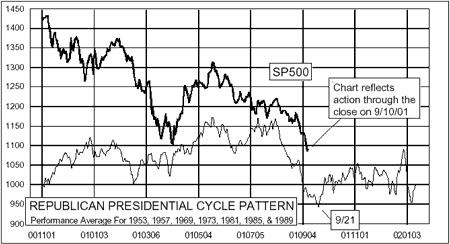
Setting the stage first, the stock market has been in a pretty bad decline already since its May 2001 top, but our Presidential Cycle Pattern has been calling for a bottom in September. Up until now, the market has been following the Republican variant of this pattern quite closely. It is a legitimate question as to whether this attack is what fulfills the expectation of the Presidential Cycle Pattern, or whether this is the asteroid in the ocean which negates the surf forecast for beachgoers.
Our take right now is that this disaster will be what finally brings the market bottom. For one thing, investors will now be shaken out of their worries about quarterly earnings preannouncements which have kept investors in a constant state of worry about the economy. Now they have something else to worry about that can enable them to take their minds off of earnings (which we should remember are a lagging indicator anyway).
For another thing, such disasters are usually buying opportunities as the charts that follow will illustrate. But there is a big caveat to that; disasters are buying opportunities, but just not right away. Those who have been previously inclined to sell will be joined by those inclined to panic, and they will be bringing sell orders to the market once it opens. But the confidence necessary for a trader to be a buyer in the face of calamity takes a while to develop. For this study, we will examine major exogenous factors that rocked the market. We will exclude events like bank panics and the 1987 crash which were caused by events within the market, preferring to focus on external events that affect stock prices. For the sake of continuity, we will look at events chronologically, and all charts on the pages that follow show the DJIA.
WWI
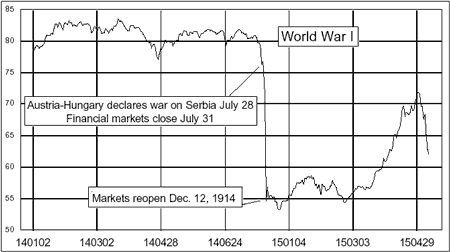
The top chart on page 2 shows the action of the DJIA at the beginning of World War I. The precipitating event was the assassination of Archduke Ferdinand on June 28, 1914, but the countries of Europe were experiencing increasing tension for many years. The declaration of war by Austria-Hungary sent worldwide financial markets into an initial panic, and the NYSE was closed later that same week for fear that European investors would pull capital out of the U.S. markets. The DJIA’s close on July 31, 1914 was at 71.42, and when trading reopened on Dec. 12, 1914 the posting for that day was 54.62, a 24% drop. The DJIA went a little bit lower later that month, but then began to mount a rally once it was clear that the damage would not continue.
Pearl Harbor
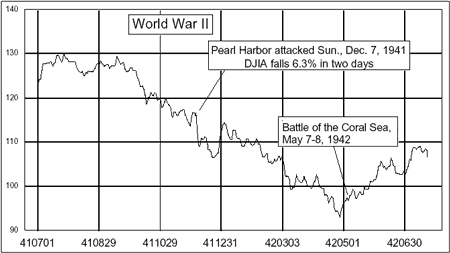
The December 7, 1941 attack on the U.S. Naval Base at Pearl Harbor, Hawaii caught America by surprise. That attack bears a lot of similarity to the current crisis in terms of the severity of the attack on the intended target as well as the element of surprise. In our opinion, the additional similarity between Pearl Harbor and the current crisis is that both are examples of a remarkable tactical victory for the attackers, but a stupendous strategic mistake. America has been called a sleeping giant which has a nasty temper when roused. We have been fortunate in our 225-year history to have sustained only a handful of attacks upon our land, so we believe that this attack will shock Americans in such a way as to make them now willing to support a much bigger counterattack on the forces of terrorism, just as America was willing to support a bloody battle throughout the Pacific theater to defeat Japan.
What is important to understand about the stock market’s reaction following the attack on Pearl Harbor is that the stock market did not begin to find its footing until the U.S. Navy’s victory at the battle of the Coral Sea. It was that victory which gave all Americans (including stock investors) the feeling that there might a positive resolution to the war. That same sort of feeling was a big factor in the market’s recovery from the Persian Gulf War in 1991, which we will cover below, and it will be a factor this time as well, but we cannot say exactly in what way.
Korean War
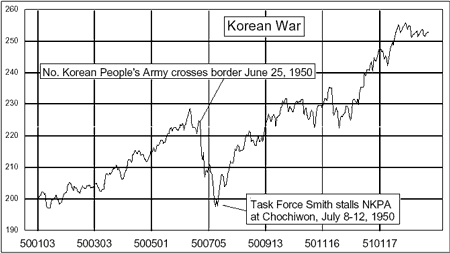
The stock market spent most of 1949 and 1950 recovering from its disappointment that Truman had in fact beaten Dewey, and it was quite a nice recovery that was under way. The attack on South Korea by the North Korean People’s Army (NKPA) was a big surprise for all concerned, especially to a world that thought World War II had ended armed conflict. The DJIA immediately began a 12% decline which was not halted until U.S. forces, hastily transported from Japan, were able to achieve some sort of limited victory. The bottom chart illustrates the effect on the DJIA. That “victory”, if it can really be called such given the heavy American casualties, was the critical turning point for the market’s decline, much like the victory in the Battle of the Coral Sea.
Eisenhower’sHeart Attack
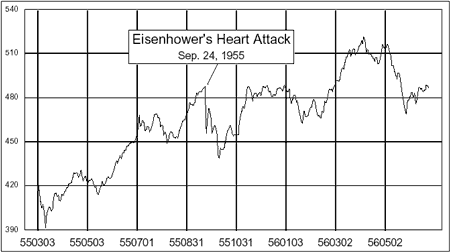
On September 23, 1955, President Eisenhower suffered a heart attack while traveling in Colorado. He was sequestered for 7 weeks in Fitzsimmons Army Medical Center (how would you like to have that HMO?) but was released with a clean bill of health. The market suffered a comparatively mild panic, especially since it was in September and October, and then proceeded to march further upward. This was a great example of a crisis that turned out to have no real impact on the economy or the country, and so the market recovered as if it did not really happen.
JFK Assassination
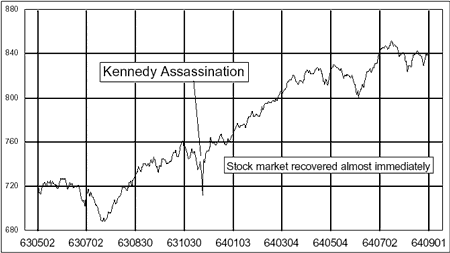
The tragic murder of President John F. Kennedy in Dallas on Nov. 22, 1963 cause a minor panic in the stock market which is understandable, but this is perhaps one of the best examples of a disaster being a buying opportunity. The assassination touched all Americans in a deep way and affected politics to a great extent, but the effect on the stock market outside of the week-long period following the shooting was almost nonexistent. Like with Eisenhower’s heart attack, there was no real damage to the economic machine of the country, and the smooth transition of power to then-VP Johnson assuaged investor worries.
Hurricane Gloria
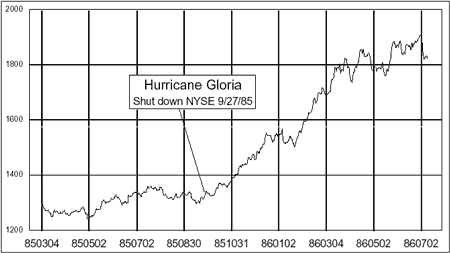
For two weeks in September 1985, Hurricane Gloria beat up on the east coast, and she even forced the NYSE to shut down on Sep. 27, 1985 after only a few minutes of trading. Most stock market databases do not even include the limited data for that day because it was so short and so few stocks actually opened. Unlike the acts of man mentioned elsewhere in this Report, Hurricane Gloria was an act of God and so investors were not nearly so upset by it. It did not at all affect investors’ willingness to trade, merely their ability to do so. Once she passed by, Gloria’s effect on investors was gone. The current crisis will be much different by comparison because of the human/economic implications behind the stop of trading.
Persian Gulf War
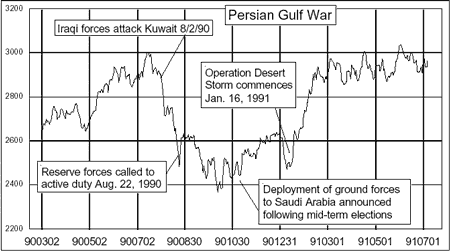
Saddam Hussein’s forces drove their tanks across the border into Kuwait on Aug. 2, 1990, seizing property, killing civilians and soldiers, and raping women. But more important to the financial markets was that Saddam’s army seized Kuwait’s oil fields and also threatened Saudi Arabia’s oil fields, home to 25% of the world’s oil production at that time. The economy was already teetering on the brink of recession before the attack, thanks to excessive rate increases by the U.S. Federal Reserve, but the threat of drastically higher oil prices and even a potential cutting-off of supplies really scared investors.
But as we saw from the examples of World War II and the Korean War, the stock market’s pain really did not begin to abate until the news started showing a turn in the conflict. By October 1990, Saddam’s assault appeared to stall in Kuwait and it appeared less likely that he might continue onward toward Saudi Arabia. The coalition of nations which came together to oppose Saddam was also beginning to strengthen by October 1990, helping to put the bottom in. As the chart at the top of page 4 shows, it was news of the commitment of U.S. forces that got the market really rallying and brought a final end to the illness which had afflicted the market. Even the incremental announcements of greater U.S. action to turn back Saddam’s efforts brought about momentary relief at points along the way.
1st WTC Bombing and Oklahoma City
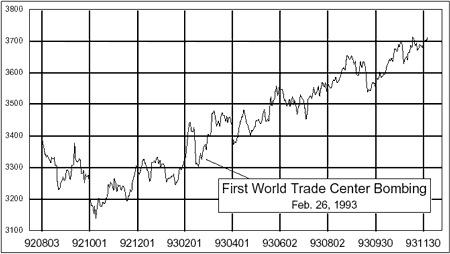
A car bomb exploded in the basement parking garage of one of the twin towers at noon on Friday, Feb. 26, 1993. Given the reaction to the current crisis, it may seem curious that there was not as much of a stock market reaction to that prior terrorist incident. Several factors played into this nonreaction. First, it was not immediately clear that it was a terrorist bomb; all that authorities knew at first was that there had been an explosion. Second, it occurred on a Friday afternoon, and by the time it was clear that a terrorist attack had occurred, the stock market was closed for the weekend. That two-day break in trading allowed traders to digest the news and to realize that while the building was damaged, it was indeed still standing. No real disruption of trading mechanisms took place, and on the Monday after the bombing, traders went back to work as if nothing had happened.
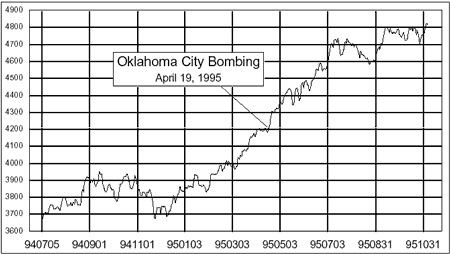
The attack on the Murrah Federal Building in Oklahoma City was initially thought to have been done by Islamic terrorists, resulting in calls for the Claude Rains solution (as Capt. Louis Renault in Casablanca, he promised to “Round up the usual suspects”). Only later was it revealed that American citizens were behind it. But even though Americans were shocked by the tragedy, traders did not perceive this as a threat because they had just recently survived the first World Trade Center bombing without any effect on the stock market. This absence of a perceived threat is important when we analyze the current situation.
BOTTOM LINE
Crises like the terrorist attacks this week against the United States are almost uniformly buying opportunities, eventually. What is important to understand is that the buying opportunity does not come the moment that trading reopens. The sellers have to exhaust their panic while the buyers have to build up enough courage to come back in. The turning point for the markets will come when the tide of the battle reverses, in whatever form that reversal is perceived by investors. We think that our projected bottom dates of Sep. 17-21 may indeed turn out to be the bottom of this selloff. Following the bottom, whenever it does come, we look for a really strong rally in the stock market, and we are probably the only ones saying so right now. That in itself should say something.
The Current Crisis
This week’s terrorist attack is causing world stock markets to decline because traders perceive this one to actually be an economic threat. The terrorists struck at the heart of capitalism in addition to damaging the actual capitalist machine, i.e. the banking system which had a lot of its offices in the area of the World Trade Center. How quickly the stock market can rebound depends on how quickly investors perceive that a concrete action is taking place that will turn the tide in this “battle”. That could be even a single arrest of a conspirator. The Fed has helped by making currency available to the banks, and it might cut interest rates as a feelgood gesture. If there are continued attacks over the next few weeks, then the stock market damage could continue.
But the most likely resolution is that this event will create a big buying opportunity a few days after trading reopens. We think that the market could rise 20% or more in just the next few months as investors recover from their feeling of panic and injury. And in all likelihood, our bottom signals for Sep. 17-21 will turn out to be the price low.